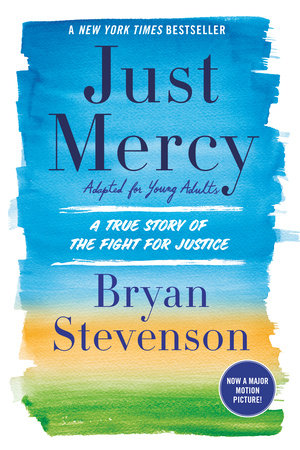Just Mercy Teach-Alike with To Kill a Mockingbird
The New York Times calls Just Mercy “as compelling as To Kill a Mockingbird, and in some ways more so.” Like in To Kill a Mockingbird, Bryan Stevenson delves deep into the broken U.S. justice system, detailing from his personal experience his many challenges and efforts as a lawyer and social advocate, especially on behalf of America’s most rejected and marginalized people.
If your curriculum includes To Kill a Mockingbird, consider reading and discussing Just Mercy as a teach-alike. See below for sample discussion topics and questions, and be sure to check out the Just Mercy Discussion Guide for School- and Community-Wide Reading Programs!

Just Mercy (Adapted for Young Adults) By Bryan Stevenson
In this very personal work—proceeds of which will go to charity—Bryan Stevenson recounts many and varied stories of his work as a lawyer in the U.S. criminal justice system on behalf of those in society who have experienced some type of discrimination and/or have been wrongly accused of a crime and who deserve a powerful advocate and due justice under the law.
Through the Equal Justice Initiative (EJI), an organization Stevenson founded as a young lawyer and for which he currently serves as Executive Director, this important work continues. EJI strives to end mass incarceration and excessive punishment in the United States, working to protect basic human rights for the most vulnerable people in American society.
The Meaning of Mockingbird
Discuss the phrase “to kill a Mockingbird” with your students. Since a Mockingbird is neither a pest nor a game bird, killing one is unnecessarily cruel. Who is the “Mockingbird” in each novel? Who or what is responsible for the mistreatment of the “Mockingbird”, and why does it continue to happen?
The Justice System
In To Kill a Mockingbird, the jury finds Tom Robinson guilty, despite compelling evidence that he is not. In Just Mercy, Walter McMillan is just one example of many low-income individuals and/or people of color presumed guilty before presenting their cases. What are other examples Bryan Stevenson shares? Why is a guilty verdict and/or a death sentence more likely if a defendant is black and the victim is white (80 percent of people on death row are convicted of crimes against whites, although 65 percent of homicide victims are black)? Do you think race and class should factor into a court case?
Complicit in Systems of Injustice
Bryan Stevenson writes “We are all implicated when we allow other people to be mistreated”? Who participates in and benefits from the systems of injustice in To Kill a Mockingbird? Do you believe that we have personal responsibility for how other people are treated? If yes, how should we be involved? If no, why not? Who does?
Racial Bias
Bryan Stevenson writes that there are four primary institutions that shape the conversation around race and justice today: slavery; racial terror and the threat of violence against people of color; Jim Crow laws, which legalized segregation; and mass incarceration. How do you see these institutions impacting Maycomb and affecting cases throughout the book? How do we see the history of racial bias in the United States impacting the criminal justice system today?
Take Action
Brainstorm ways to work towards just systems. Use the list of suggestions on how to take action from the Just Mercy Discussion Guide.



